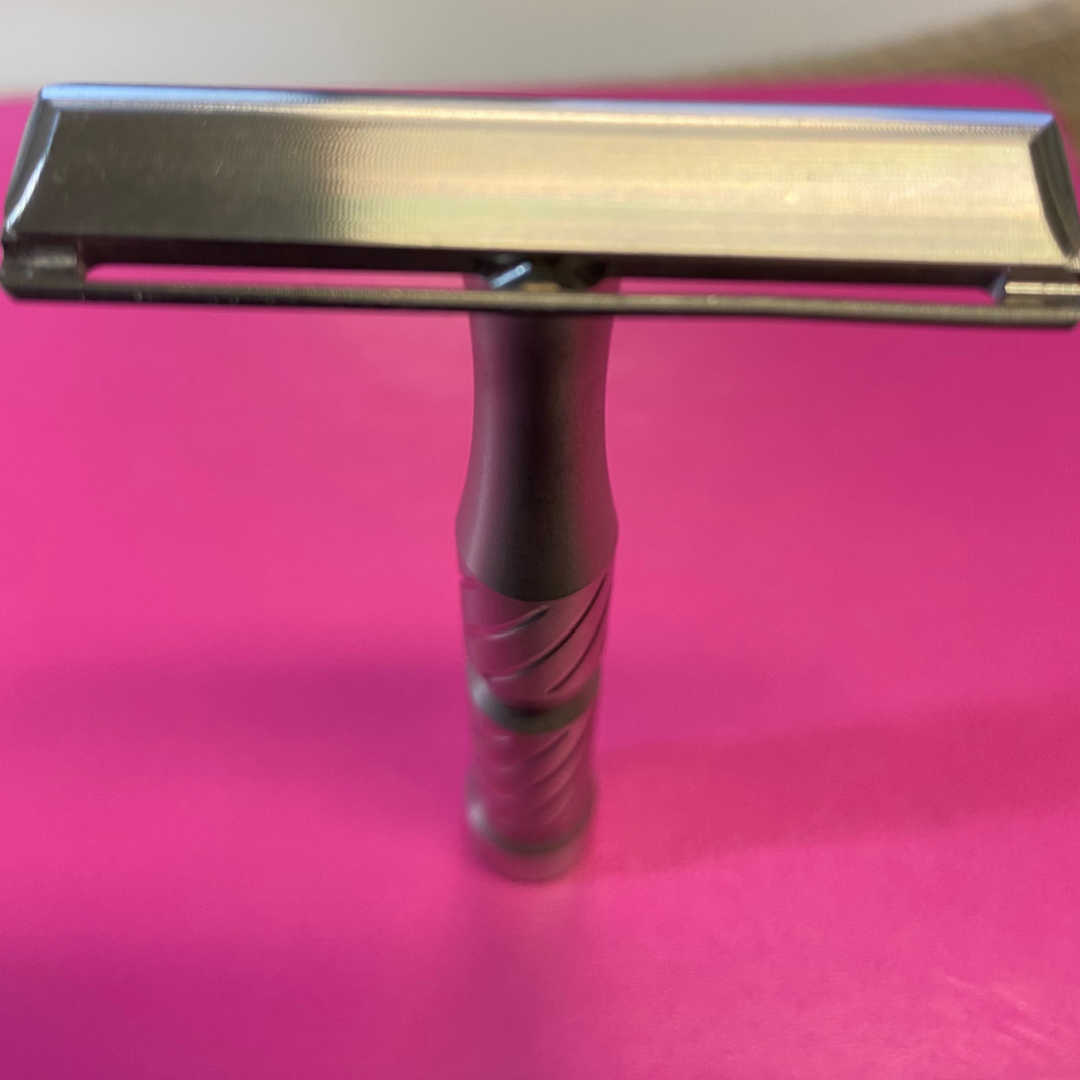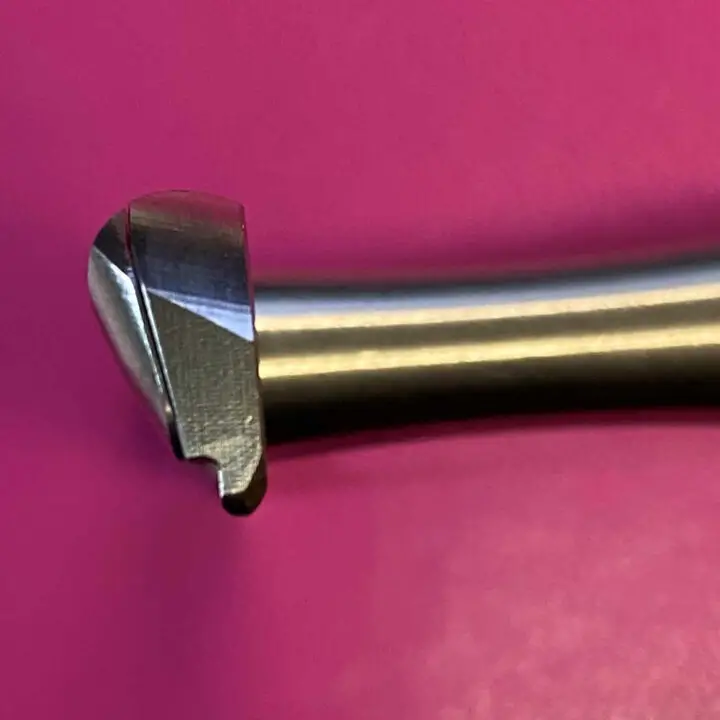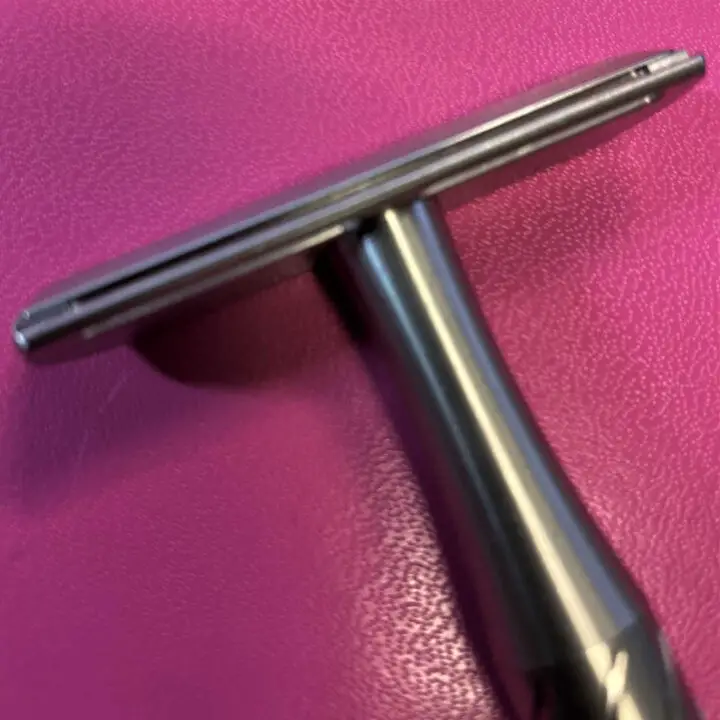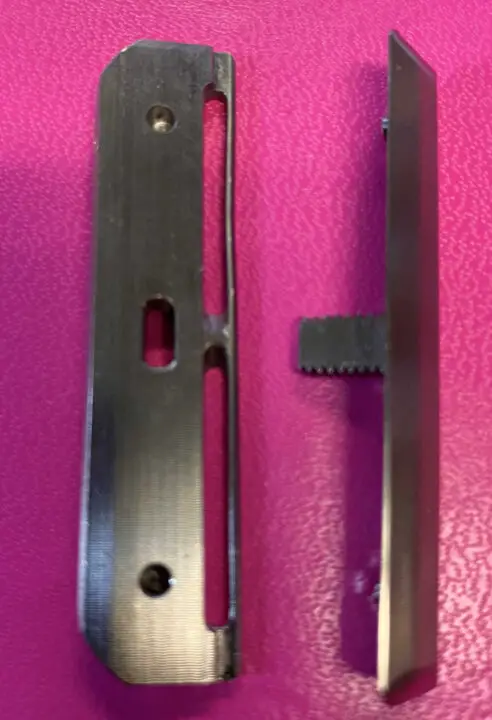
In my previous article, we discussed the “SE alternative” to DE shaving as a concept, and discussed the various “families” of AC blades. Let’s move in a more specific direction now, and dig into an excellent example of an AC blade design, the Blackland Vector.
Blackland Vector Key Takeaways
[Ed. Note: Blackland links are affiliate.]
The Blackland Vector is an SE razor made by Blackland, a razor maker founded in 2015.
Pros:
- Maneuverable and sleek head design that makes it easy to shave hard to reach areas
- Efficient razor which does not cut or irritate
- Light but not too light
- Impeccable build quality and handsome aesthetics
- Well designed handle that looks good while also maximizing control
- Excellent warranty and customer service
- American designed and made
Cons:
- High cost
- Cannot use all AC type blades
- Significant blade feel
- Head sometimes (rarely) loosens during shave
- Some do not like machined finish
- Significant surcharge for polished finish
Blackland Vector
A vector is a quantity of direction and magnitude of force. It is also the name of an SE razor made by Blackland, a razor maker founded in 2015. Shane Swartzlander (just guess what his last name means…) is the founder and owner and reassures customers that all his products are made in the US and that all his employees receive both a living wage, a good working environment, and a decent portfolio of benefits such as a 401k and flex time.
Blackland’s first razor was the Blackbird, a sleek SS DE styled to look a little bit like the famed SR-71 Blackbird reconnaissance aircraft. The Blackbird was efficient, aggressive, and proved very popular. The razor line expanded to include various other metal Blackbird variants, along with some short lived DE stablemates (the Dart and the Era), a GEM design the Sabre (more on that soon!), and a radical new AC razor concept, the Vector.
What’s so radical about the Vector? Well, most AC razors like the RazoRock Hawk and Colonial General use heads that are generally similar in dimensions to the heads of DE razors – that is to say they tend to be roughly the same thickness and height as DE heads, while being wide enough to accommodate the AC blade, which is roughly 50mm long.

Dimensions?
It might be worth to discuss blade dimensions here. A standard DE blade is roughly 37mm long (on the longest side, where each blade is), about 11mm wide (from one the edge of one sharp side across to the other one), and a mere .11mm thick. A Feather AC by comparison is 50mm long as stated above, is 8mm wide, and between .25 and .31mm thick. So we see that when making an AC razor head, a manufacturer can get by with using a standard DE head and simply modifying it by making it longer.
The Genius Of The Vector
The genius of the Vector (whose pricing starts at $220) is that Blackland sculpted the head to be extraordinarily skinny and shallow. The head is roughly as wide as its blade, and only slightly thicker. This, combined with a light and thin top cap, makes for a very maneuverable head, able to get into the less accessible areas of a face and neck (or even a head!) easily.

The more precisely shaped head also makes for a lighter total razor weight, 77 grams versus 84 to 90 grams for other SS AC razor designs. Shaving under my nose or in the cleft of my chin has never been easier. The head design also makes for easy buffing action, which when combined with the sharp AC blade can lead to less need to do against the grain passes.
The design of the Vector also features a pretty unique handle. Skinny, with ascending spiral grooves interrupted at several points with a notch, the Vector handle is comfortable to hold, and offers good grip even when wet. The handle is 92mm long, which is pretty average, and the entire razor is made from 303 stainless, which is again very standard in the field.
I should mention that the Vector also has a titanium variant, and both metal frames can be ordered with an open comb base plate at no extra charge, or with both safety bar and OC plates for an added $80.
A Slight Vector Off Course
Two special possible design concerns should be mentioned. First the standard finish on the razor is called “machined”, which displays machining marks. These marks are pretty orderly (i.e. not random) and not at all unattractive, but the finish does feel a bit draggy versus other makers who utilize polished or matte designs.
This dragginess is not at all a big deal and is barely noticeable, at least to me, but some online feel more antipathic towards the face feel of this finish. One can avoid the whole possible issue here by shelling out an extra $50 for the “polished” finish, which looks real purty and also has no perceptible drag at all even to the saltiest of internet sages.
Second issue: if you look at the linked Vector page from the manufacturer you see there’s a table of “approved blades”. Conspicuously absent from that list is the Schick Proline P-20, an AC blade that many (including myself) find to be the most appealing of the various AC blade types.
The Proline combines a milder first shave with excellent efficiency, a long lifespan, and (dependent on the vagaries of internet pricing) a price that can be a bit cheaper than Feather Pros, which are sort of the standard in AC shaving.
Why is the Proline missing? Interesting tale there. Per my email exchange with Mr. Blackland, Schick apparently has some hit and miss moments on their assembly line and their Prolines can vary very slightly from one example to the next. These slight variances can result in a Proline not fitting on the Vector’s head mounting posts which are very precisely designed to exactly match the standard AC parameters.
As a result, maybe only 1 in 3 Prolines will fit the Vector properly. From experience, I’ve found you can force another 1 in 3 onto the posts – but then getting that blade off the post is gruelingly unpleasant and the shave might be impacted due to the extra tension added into the blade after being muscled onto the posts.
And the third Proline in this sample set will not fit at all on the Vector no matter how much brute force is added to the process. Basically then, most of a given pack of Prolines will be unusable or problematic for use in a Vector. I’d suggest not trying them for that purpose. They do work well in other AC razors though, so the tolerance interplay (can we call it “intolerance”?) is an issue only with Prolines and Vectors interacting.

At first, the cynical consumerist in me thought the Blackland guy was just making this up to explain some manufacturing imprecision in his own manufacture of the Vector. After running through dozens of examples of six different brands / types of AC blades, I would have to say the above explanation is accurate. The only blades that ever had an issue with fitting in a Vector were the Schick Prolines, so caveat emptor.
In truth, avoiding use of Prolines is not that big of a deal. Prolines were only significantly cheaper than Feather Pros when ordered directly from certain Japanese Rakuten vendors (complete with oceanic shipping for added anticipation), and if one uses Amazon Subscribe and S(h)ave, you can get Feather Pros for 76 cents per blade, which is within a few cents per blade of the best Rakuten prices I found in the past.
The Feather Pro has a harsher first shave, but then settles down and shaves as comfortable and efficiently as a Schick Proline, so as long as you either can cope with a somewhat more challenging first shave (or want to cork the blade) the Feather Pro is a more than acceptable substitute for the somewhat erratic Proline.
Vector Me In The Right Direction
So with those possible issues addressed, let’s talk about how the Vector shaves.
My other AC razors (a General, two Hawks, one aluminum and one SE, and an ATT SE1) are considerably milder than the Vector. In particular, the blade feel is much less in all, and the relative shaves vary from slightly less efficient (the General and the SE1) to considerably less efficient (the Hawks).
Blackland calls the blade feel in the Vector a 5 of 10 and its efficiency a 7 of 10. I’d agree with the efficiency but would nudge the blade feel up to a 7 also. Mr. Swartzlander must have some mighty tough skin / stubble, as I’d say blade feel on all the Blackland models is significant. Not a bad thing though, as I don’t think I’ve ever shed a drop of blood from using any Blackland model (and I have three of them) nor had any irritation.
Rather for me, the pitfall of blade feel is that I tend to back off on the shave, thinking blade feel equals danger, so I shave less aggressively, meaning the perhaps ironic outcome for me with blade feel is worse shaves. Again though, the Vector is perfectly safe to shave with; you just won’t forget you are running a really sharp piece of metal over your face! Many users are perfectly fine with blade feel, but the subject should be mentioned.
In terms of sharpness, the AC Feather Professional will disappoint few, if any. Sharpness of any AC blade type (to be discussed later) is at least as sharp as any DE and usually much sharper. Unlike some sharp DE blades (e.g. Feather DE) that are quite sharp but then dull quickly, the AC starts sharp, and stays sharp over a double digit number of shaves.
Once we move past the blade feel, the Vector is a delight to shave with. The nimble and precise head encourages quick adjustments during a shave to cover problem areas, and the relative light weight of the razor reduces any possible hand fatigue.
The longer blade covers about 33% more facial real estate in a given swipe, and this, plus the weight and quick direction change capability, along with the generally excellent sharpness of AC blades means one can speed through a multi-pass shave more quickly than one could using a DE razor. For me, the time savings comes to maybe 1 to 2 minutes less for my standard two pass, all directions shave.
Do make sure the Vector head is tightly screwed down before you start shaving and then also at the beginning of each pass. In hundreds of shaves, the Vector head loosened up maybe 2 or 3 times, and a loosened head does weird and awful things to the blade gap, so use an ounce of prevention.
The Vector is very efficient and can give me an easy BBS in two passes, which level of unhirsuteness will last for roughly 10 hours, with some variance in duration dependent on blade use. As mentioned earlier, despite the blade feel and efficiency, the Vector has always treated me kindly and has not irritated or cut me.
The Vector has a certain intangible feel to it, one that builds user confidence. I generally like to use a mirror for shaving and avoid using DEs in the shower due to the absence of such a device in my bathroom. Very few razors make me confident enough to try them in the steamy and mirrorless bathtub, and those which I do use are mostly carts, which I reluctantly take up when pressed for time. The understanding on such occasions is that I will get a crappy shave with lots of remaining stubble as the price paid for speed and convenience.
The Vector though seems to point and angle itself almost instinctively, like a good bird dog or highly ergonomic tool. As a result, the Vector is one of a very few non-cartridge designs that I am happy to use for the occasional shower speed shave. The Vector is fast, intuitive, and reliable.
As far as blade life, I can get at least 10 shaves out of an AC Feather Pro, usually more like 12 to 14 shaves. As I mentioned up front, this does not beat all DE brands in my experience, but it does beat most. Shaves for other types of AC blades vary a bit, and this will be discussed later.
Warranty is a 30 day no questions asked return policy along with a lifetime guarantee on any defects due to materials or workmanship. I know from dealing with Blackland on other razor issues that they do indeed stand by this generous warranty and are trustworthy and efficient in resolving issues that arise.
Conclusion
As I mentioned, I cannot verify that using an AC blade or razor will get rid of blade chatter. But I can tell you that AC shaving, especially with the Vector, feels very different from any sort of DE shaving. A clean, efficient, and fast shave is the norm, and the variety of blade types enable a bit of experimentation that will make DE shavers feel right at home. (GEM and Injector blades have little to no options in comparison.) The extremely well-made Vector is pretty to look at, feels slick to use, and seems like it will last for decades. In short, whether you think you are experiencing blade chatter or not, and whether or not you are weeping with boredom from conquering the DE world, a Vector is a fine addition to your shaving hardware.
In my next installment, I’ll discuss the varieties of Artist Club blades available for use in the Vector (or any other AC razor). There is quite a bit of choice here, though not as much as with DE razors.

There’s definitely a bend in the baseplate, top part as seen in the picture…
Personally, I think the Vector with a Schick blade is the final destination for this wet shaver. Every now and then I go back to one of my large collection of safety razors to see if my love affair still holds. After about three days I’m missing the Vector and happiest when reunited.
I do like the Vector and prefer the Schick Proline if all goes well, but occasionally have to send a Schick over to my Colonial General for use when it does not fit in the Vector. All good, as the Feather Pro blades are a close runner up!
Just to pick at nits. The width of a blade edge to edge is 22mm. The 11mm you gave would be a half blade. A newbie might get confused.
Very true, my bad! A DE blade is 22mm wide edge to edge. Thanks for the correction!
Double edge man til my dying day
No reason not to be! The Vector (and other SE blades) are for experimenters, completionists, and those possibly concerned about blade chatter. All these groups are a small subset of DE shavers, and most DE shavers can rest content in the core aspect of the hobby.
Comments are closed.